
kubesphere
The container platform tailored for Kubernetes multi-cloud, datacenter, and edge management ⎈ 🖥 ☁️
Stars: 15078
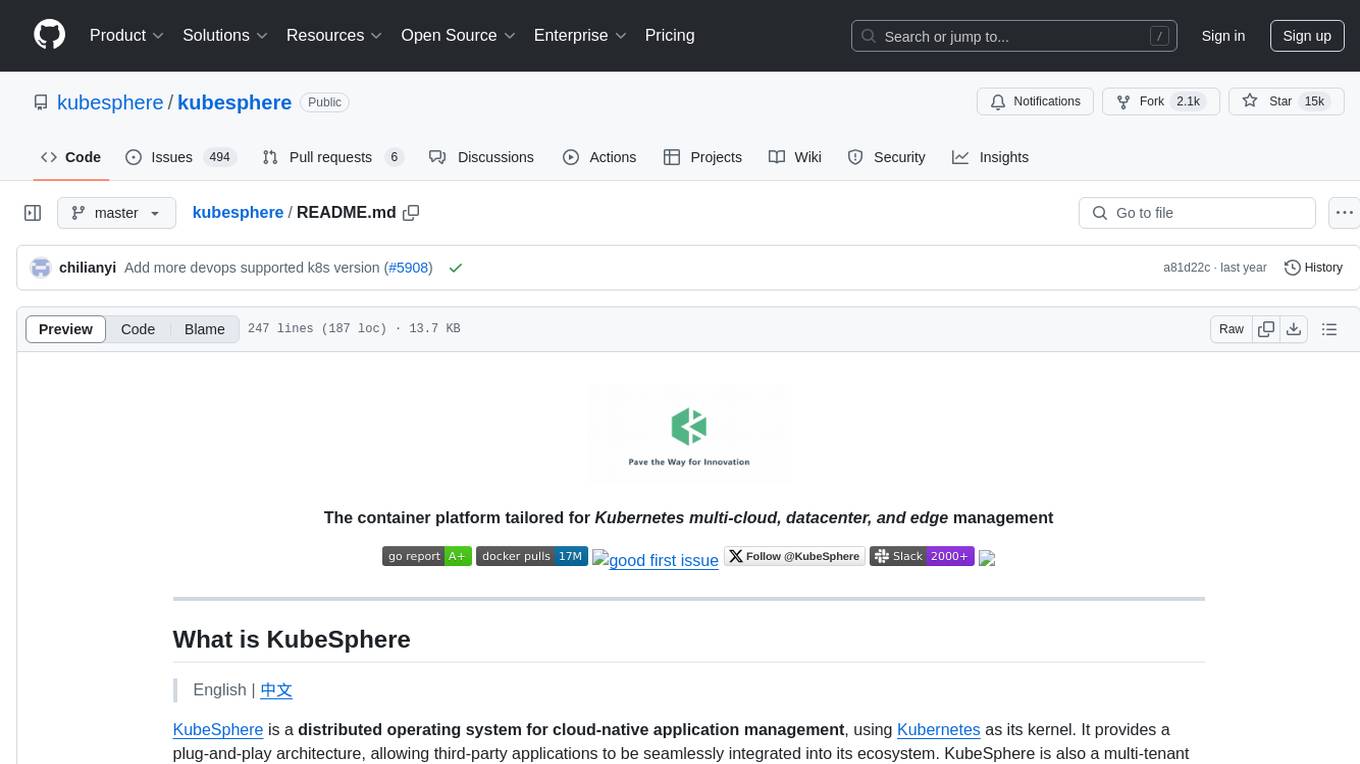
KubeSphere is a distributed operating system for cloud-native application management, using Kubernetes as its kernel. It provides a plug-and-play architecture, allowing third-party applications to be seamlessly integrated into its ecosystem. KubeSphere is also a multi-tenant container platform with full-stack automated IT operation and streamlined DevOps workflows. It provides developer-friendly wizard web UI, helping enterprises to build out a more robust and feature-rich platform, which includes most common functionalities needed for enterprise Kubernetes strategy.
README:
The container platform tailored for Kubernetes multi-cloud, datacenter, and edge management
English | 中文
KubeSphere is a distributed operating system for cloud-native application management, using Kubernetes as its kernel. It provides a plug-and-play architecture, allowing third-party applications to be seamlessly integrated into its ecosystem. KubeSphere is also a multi-tenant container platform with full-stack automated IT operation and streamlined DevOps workflows. It provides developer-friendly wizard web UI, helping enterprises to build out a more robust and feature-rich platform, which includes most common functionalities needed for enterprise Kubernetes strategy, see Feature List for details.
The following screenshots give a close insight into KubeSphere. Please check What is KubeSphere for further information.
| Workbench | Project Resources |
 |
 |
| CI/CD Pipeline | App Store |
 |
 |
🎮 KubeSphere Lite provides you with free, stable, and out-of-the-box managed cluster service. After registration and login, you can easily create a K8s cluster with KubeSphere installed in only 5 seconds and experience feature-rich KubeSphere.
🖥 You can view the Demo Video to get started with KubeSphere.
🕸 Provisioning Kubernetes Cluster
Support deploy Kubernetes on any infrastructure, support online and air-gapped installation. Learn more.🔗 Kubernetes Multi-cluster Management
Provide a centralized control plane to manage multiple Kubernetes clusters, and support the ability to propagate an app to multiple K8s clusters across different cloud providers.🤖 Kubernetes DevOps
Provide GitOps-based CD solutions and use Argo CD to provide the underlying support, collecting CD status information in real time. With the mainstream CI engine Jenkins integrated, DevOps has never been easier. Learn more.🔎 Cloud Native Observability
Multi-dimensional monitoring, events and auditing logs are supported; multi-tenant log query and collection, alerting and notification are built-in. Learn more.🧩 Service Mesh (Istio-based)
Provide fine-grained traffic management, observability and tracing for distributed microservice applications, provides visualization for traffic topology. Learn more.💻 App Store
Provide an App Store for Helm-based applications, and offer application lifecycle management on Kubernetes platform. Learn more.💡 Edge Computing Platform
KubeSphere integrates KubeEdge to enable users to deploy applications on the edge devices and view logs and monitoring metrics of them on the console. Learn more.📊 Metering and Billing
Track resource consumption at different levels on a unified dashboard, which helps you make better-informed decisions on planning and reduce the cost. Learn more.🗃 Support Multiple Storage and Networking Solutions
🏘 Multi-tenancy
Provide unified authentication with fine-grained roles and three-tier authorization system, and support AD/LDAP authentication.🧠 GPU Workloads Scheduling and Monitoring
Create GPU workloads on the GUI, schedule GPU resources, and manage GPU resource quotas by tenant.KubeSphere uses a loosely-coupled architecture that separates the frontend from the backend. External systems can access the components of the backend through the REST APIs.
🎉 KubeSphere v3.4.0 was released! It brings enhancements and better user experience, see the Release Notes For 3.4.0 for the updates.
| Component | Version | K8s supported version |
|---|---|---|
| Alerting | N/A | 1.21,1.22,1.23,1.24,1.25,1.26 |
| Auditing | v0.2.0 | 1.21,1.22,1.23,1.24,1.25,1.26 |
| Monitoring | N/A | 1.21,1.22,1.23,1.24,1.25,1.26 |
| DevOps | v3.4.0 | 1.21,1.22,1.23,1.24,1.25,1.26 |
| EdgeRuntime | v1.13.0 | 1.21,1.22,1.23 |
| Events | N/A | 1.21,1.22,1.23,1.24,1.25,1.26 |
| Logging | opensearch:v2.6.0 fluentbit-operator: v0.14.0 fluent-bit-tag: v1.9.4 |
1.21,1.22,1.23,1.24,1.25,1.26 |
| Metrics Server | v0.4.2 | 1.21,1.22,1.23,1.24,1.25,1.26 |
| Network | N/A | 1.21,1.22,1.23,1.24,1.25,1.26 |
| Notification | v2.3.0 | 1.21,1.22,1.23,1.24,1.25,1.26 |
| AppStore | N/A | 1.21,1.22,1.23,1.24,1.25,1.26 |
| Storage | pvc-autoresizer: v0.3.0 storageclass-accessor: v0.2.2 |
1.21,1.22,1.23,1.24,1.25,1.26 |
| ServiceMesh | Istio: v1.14.6 | 1.21,1.22,1.23,1.24 |
| Gateway | Ingress NGINX Controller: v1.3.1 | 1.21,1.22,1.23,1.24 |
KubeSphere can run anywhere from on-premise datacenter to any cloud to edge. In addition, it can be deployed on any version-compatible Kubernetes cluster. The installer will start a minimal installation by default, you can enable other pluggable components before or after installation.
Ensure that your cluster has installed Kubernetes v1.21.x, v1.22.x, v1.23.x, * v1.24.x, * v1.25.x, or * v1.26.x. For Kubernetes versions with an asterisk, some features may be unavailable due to incompatibility.
Run the following commands to install KubeSphere on an existing Kubernetes cluster:
kubectl apply -f https://github.com/kubesphere/ks-installer/releases/download/v3.4.0/kubesphere-installer.yaml
kubectl apply -f https://github.com/kubesphere/ks-installer/releases/download/v3.4.0/cluster-configuration.yaml👨💻 No Kubernetes? You can use KubeKey to install both KubeSphere and Kubernetes/K3s in single-node mode on your Linux machine. Let's take K3s as an example:
# Download KubeKey
curl -sfL https://get-kk.kubesphere.io | VERSION=v3.0.10 sh -
# Make kk executable
chmod +x kk
# Create a cluster
./kk create cluster --with-kubernetes v1.24.14 --container-manager containerd --with-kubesphere v3.4.0You can run the following command to view the installation logs. After KubeSphere is successfully installed, you can
access the KubeSphere web console at http://IP:30880 and log in using the default administrator account (
admin/P@88w0rd).
kubectl logs -n kubesphere-system $(kubectl get pod -n kubesphere-system -l 'app in (ks-install, ks-installer)' -o jsonpath='{.items[0].metadata.name}') -fKubeSphere is hosted on the following cloud providers, and you can try KubeSphere by one-click installation on their hosted Kubernetes services.
- KubeSphere for Amazon EKS
- KubeSphere for Azure AKS
- KubeSphere for DigitalOcean Kubernetes
- KubeSphere on QingCloud AppCenter(QKE)
You can also install KubeSphere on other hosted Kubernetes services within minutes, see the step-by-step guides to get started.
👨💻 No internet access? Refer to
the Air-gapped Installation on Kubernetes
or Air-gapped Installation on Linux
for instructions on how to use private registry to install KubeSphere.
We ❤️ your contribution. The community walks you through how to get started contributing KubeSphere. The development guide explains how to set up development environment.
🤗 Please submit any KubeSphere bugs, issues, and feature requests to KubeSphere GitHub Issue.
💟 The KubeSphere team also provides efficient official ticket support to respond in hours. For more information, click KubeSphere Online Support.
The user case studies page includes the user list of the project. You can leave a comment to let us know your use case.


KubeSphere is a member of CNCF and a Kubernetes Conformance Certified platform
, which enriches the CNCF CLOUD NATIVE Landscape.
For Tasks:
Click tags to check more tools for each tasksFor Jobs:
Alternative AI tools for kubesphere
Similar Open Source Tools

kubesphere
KubeSphere is a distributed operating system for cloud-native application management, using Kubernetes as its kernel. It provides a plug-and-play architecture, allowing third-party applications to be seamlessly integrated into its ecosystem. KubeSphere is also a multi-tenant container platform with full-stack automated IT operation and streamlined DevOps workflows. It provides developer-friendly wizard web UI, helping enterprises to build out a more robust and feature-rich platform, which includes most common functionalities needed for enterprise Kubernetes strategy.
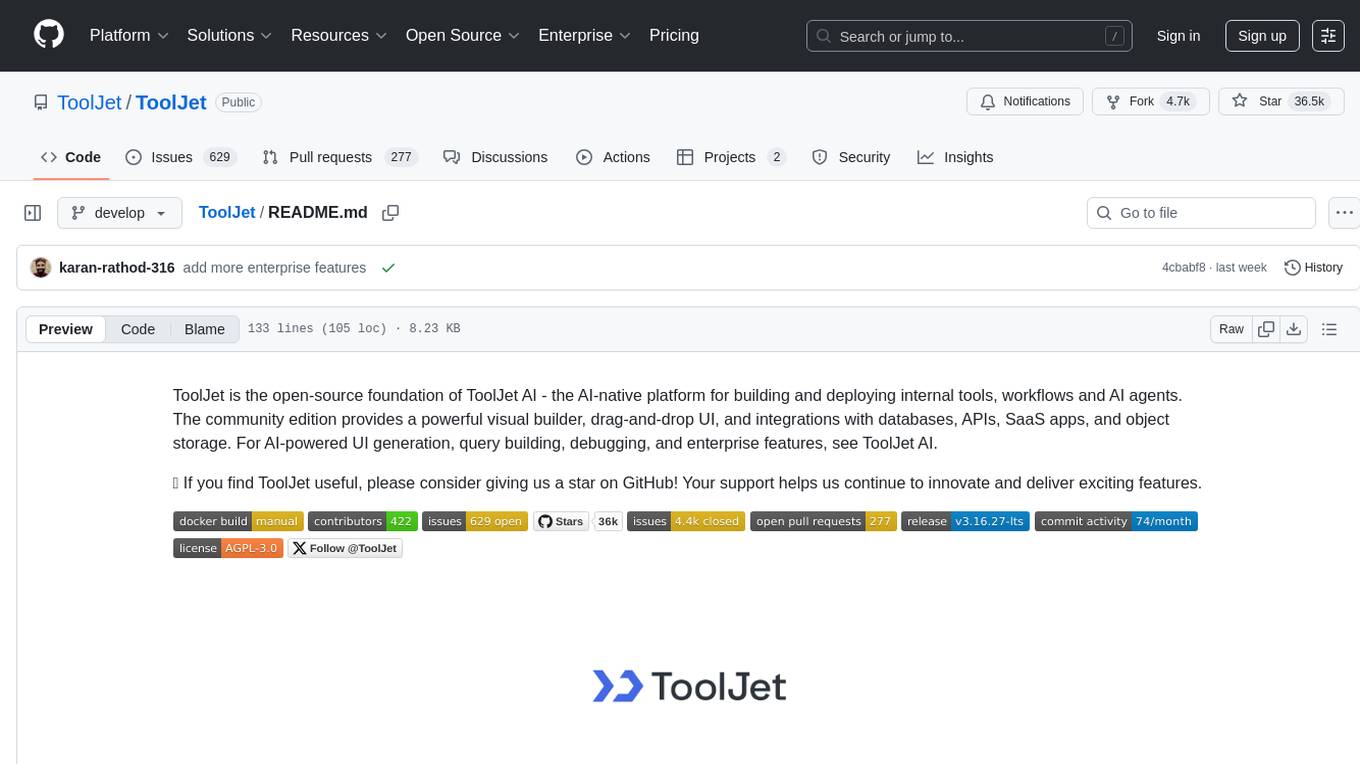
ToolJet
ToolJet is an open-source platform for building and deploying internal tools, workflows, and AI agents. It offers a visual builder with drag-and-drop UI, integrations with databases, APIs, SaaS apps, and object storage. The community edition includes features like a visual app builder, ToolJet database, multi-page apps, collaboration tools, extensibility with plugins, code execution, and security measures. ToolJet AI, the enterprise version, adds AI capabilities for app generation, query building, debugging, agent creation, security compliance, user management, environment management, GitSync, branding, access control, embedded apps, and enterprise support.
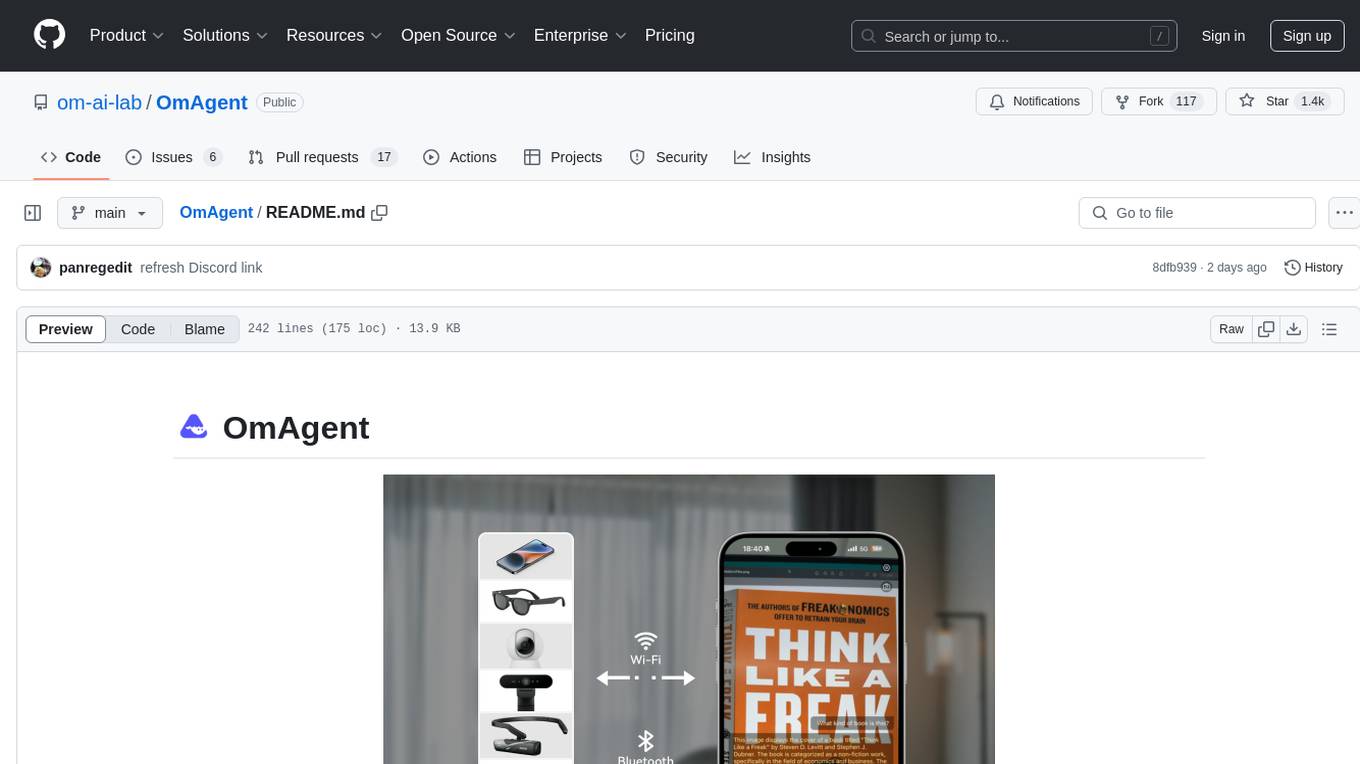
OmAgent
OmAgent is an open-source agent framework designed to streamline the development of on-device multimodal agents. It enables agents to empower various hardware devices, integrates speed-optimized SOTA multimodal models, provides SOTA multimodal agent algorithms, and focuses on optimizing the end-to-end computing pipeline for real-time user interaction experience. Key features include easy connection to diverse devices, scalability, flexibility, and workflow orchestration. The architecture emphasizes graph-based workflow orchestration, native multimodality, and device-centricity, allowing developers to create bespoke intelligent agent programs.
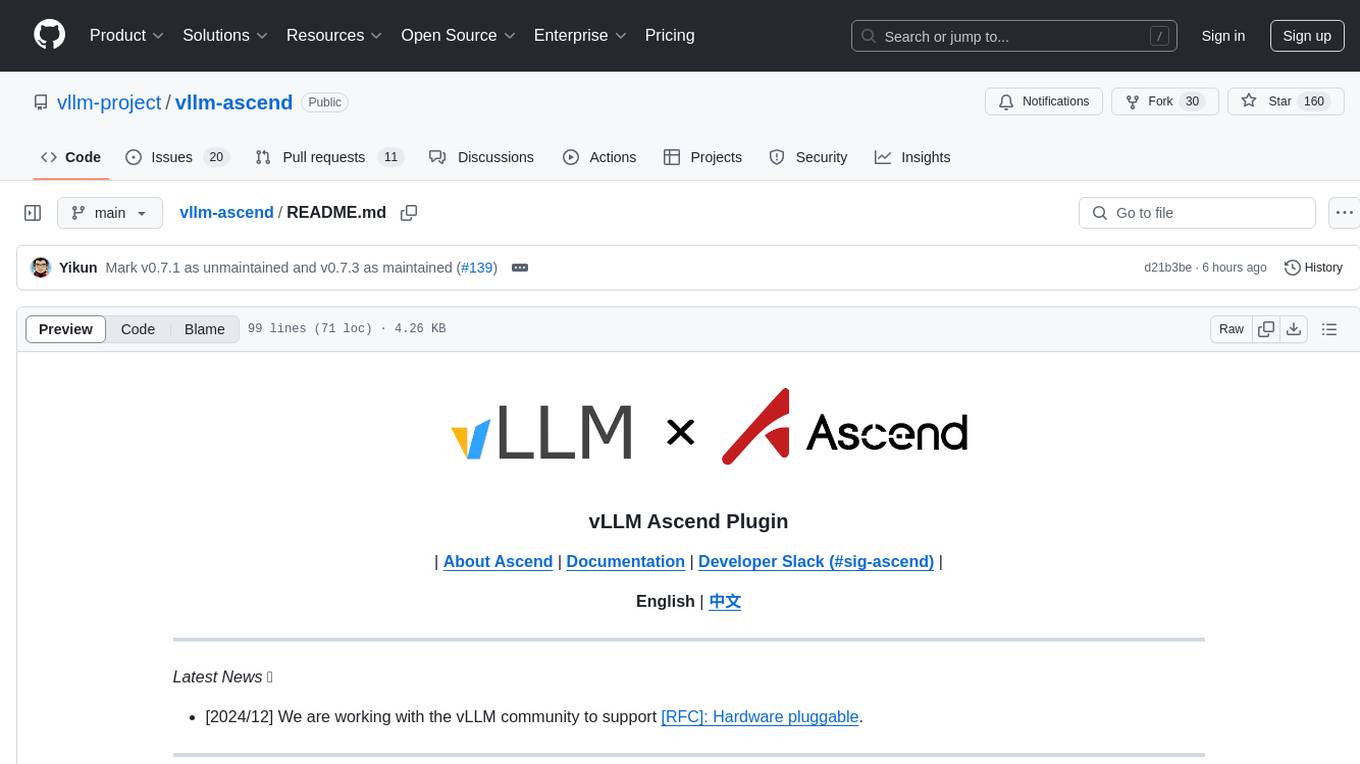
vllm-ascend
vLLM Ascend plugin is a backend plugin designed to run vLLM on the Ascend NPU. It provides a hardware-pluggable interface that allows popular open-source models to run seamlessly on the Ascend NPU. The plugin is recommended within the vLLM community and adheres to the principles of hardware pluggability outlined in the RFC. Users can set up their environment with specific hardware and software prerequisites to utilize this plugin effectively.
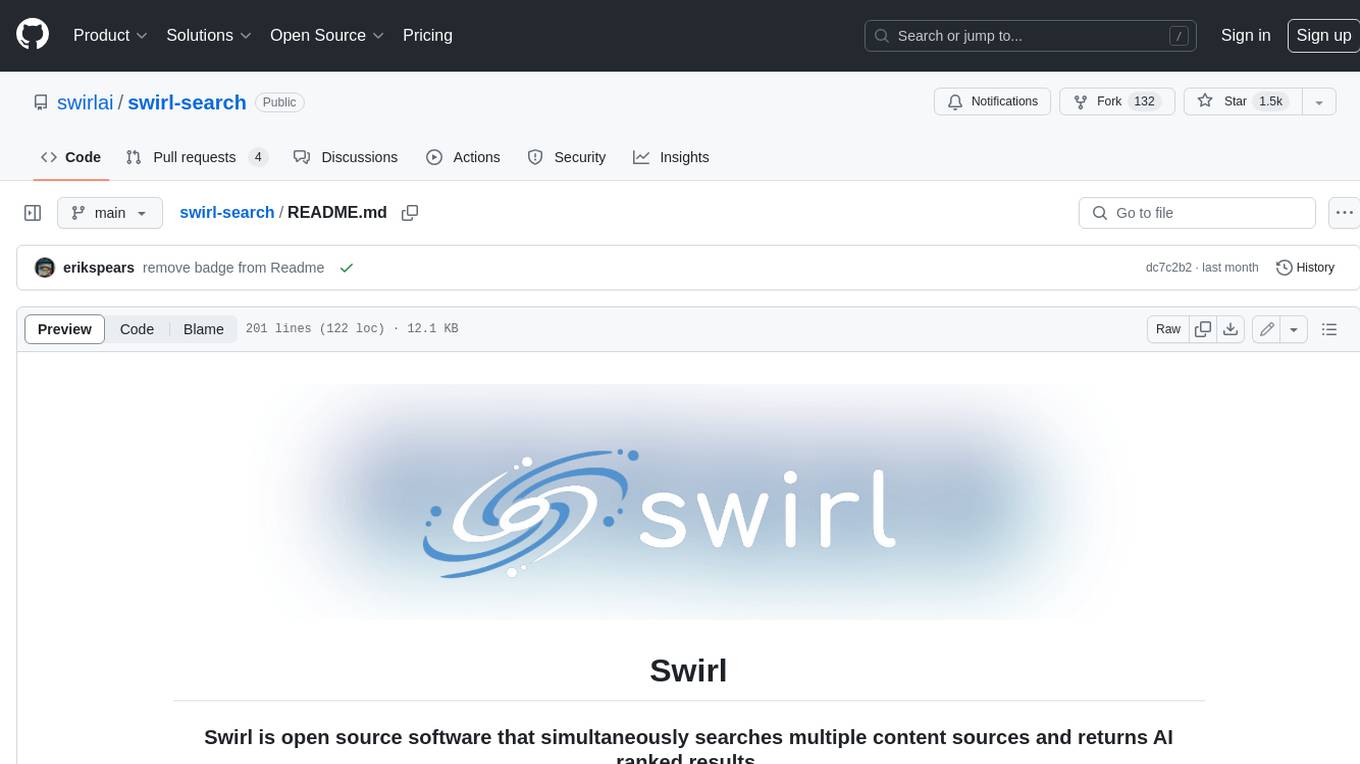
swirl-search
Swirl is an open-source software that allows users to simultaneously search multiple content sources and receive AI-ranked results. It connects to various data sources, including databases, public data services, and enterprise sources, and utilizes AI and LLMs to generate insights and answers based on the user's data. Swirl is easy to use, requiring only the download of a YML file, starting in Docker, and searching with Swirl. Users can add credentials to preloaded SearchProviders to access more sources. Swirl also offers integration with ChatGPT as a configured AI model. It adapts and distributes user queries to anything with a search API, re-ranking the unified results using Large Language Models without extracting or indexing anything. Swirl includes five Google Programmable Search Engines (PSEs) to get users up and running quickly. Key features of Swirl include Microsoft 365 integration, SearchProvider configurations, query adaptation, synchronous or asynchronous search federation, optional subscribe feature, pipelining of Processor stages, results stored in SQLite3 or PostgreSQL, built-in Query Transformation support, matching on word stems and handling of stopwords, duplicate detection, re-ranking of unified results using Cosine Vector Similarity, result mixers, page through all results requested, sample data sets, optional spell correction, optional search/result expiration service, easily extensible Connector and Mixer objects, and a welcoming community for collaboration and support.

leapfrogai
LeapfrogAI is a self-hosted AI platform designed to be deployed in air-gapped resource-constrained environments. It brings sophisticated AI solutions to these environments by hosting all the necessary components of an AI stack, including vector databases, model backends, API, and UI. LeapfrogAI's API closely matches that of OpenAI, allowing tools built for OpenAI/ChatGPT to function seamlessly with a LeapfrogAI backend. It provides several backends for various use cases, including llama-cpp-python, whisper, text-embeddings, and vllm. LeapfrogAI leverages Chainguard's apko to harden base python images, ensuring the latest supported Python versions are used by the other components of the stack. The LeapfrogAI SDK provides a standard set of protobuffs and python utilities for implementing backends and gRPC. LeapfrogAI offers UI options for common use-cases like chat, summarization, and transcription. It can be deployed and run locally via UDS and Kubernetes, built out using Zarf packages. LeapfrogAI is supported by a community of users and contributors, including Defense Unicorns, Beast Code, Chainguard, Exovera, Hypergiant, Pulze, SOSi, United States Navy, United States Air Force, and United States Space Force.
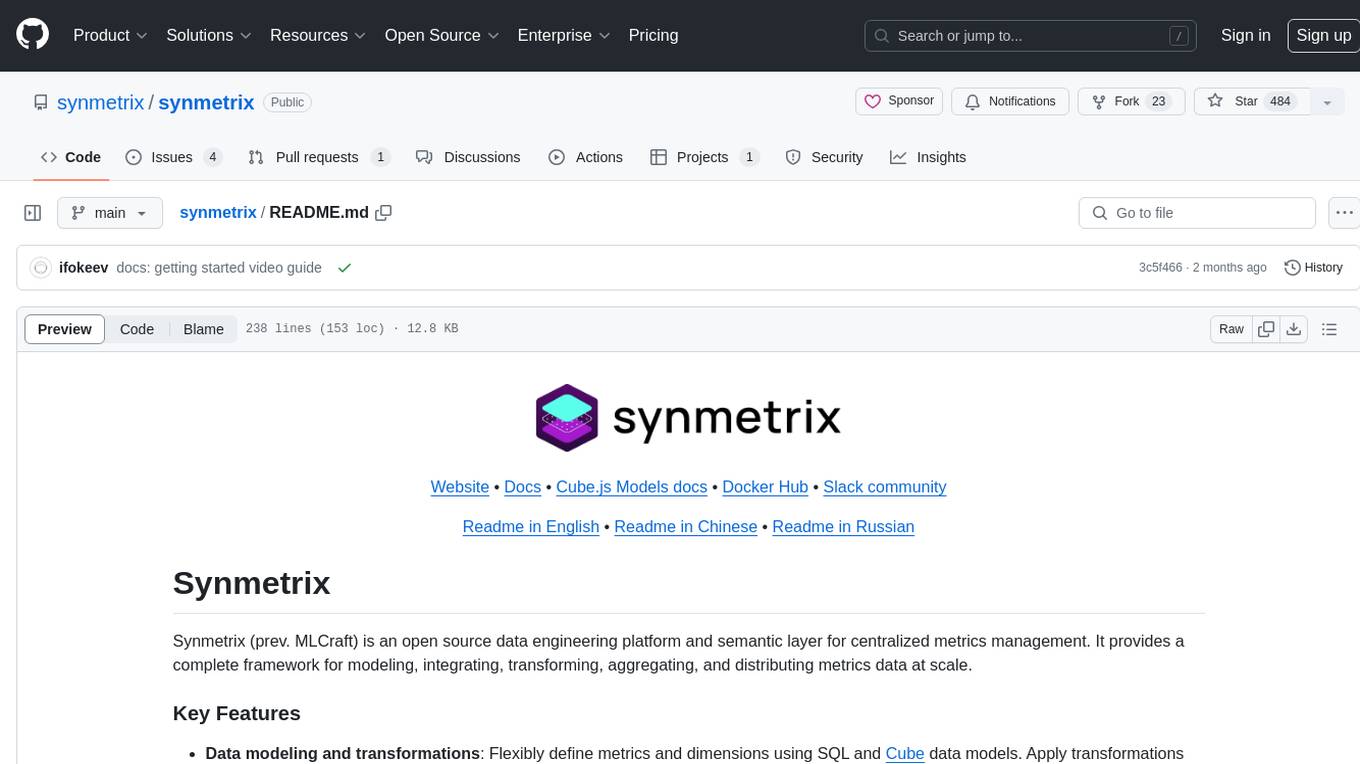
synmetrix
Synmetrix is an open source data engineering platform and semantic layer for centralized metrics management. It provides a complete framework for modeling, integrating, transforming, aggregating, and distributing metrics data at scale. Key features include data modeling and transformations, semantic layer for unified data model, scheduled reports and alerts, versioning, role-based access control, data exploration, caching, and collaboration on metrics modeling. Synmetrix leverages Cube.js to consolidate metrics from various sources and distribute them downstream via a SQL API. Use cases include data democratization, business intelligence and reporting, embedded analytics, and enhancing accuracy in data handling and queries. The tool speeds up data-driven workflows from metrics definition to consumption by combining data engineering best practices with self-service analytics capabilities.
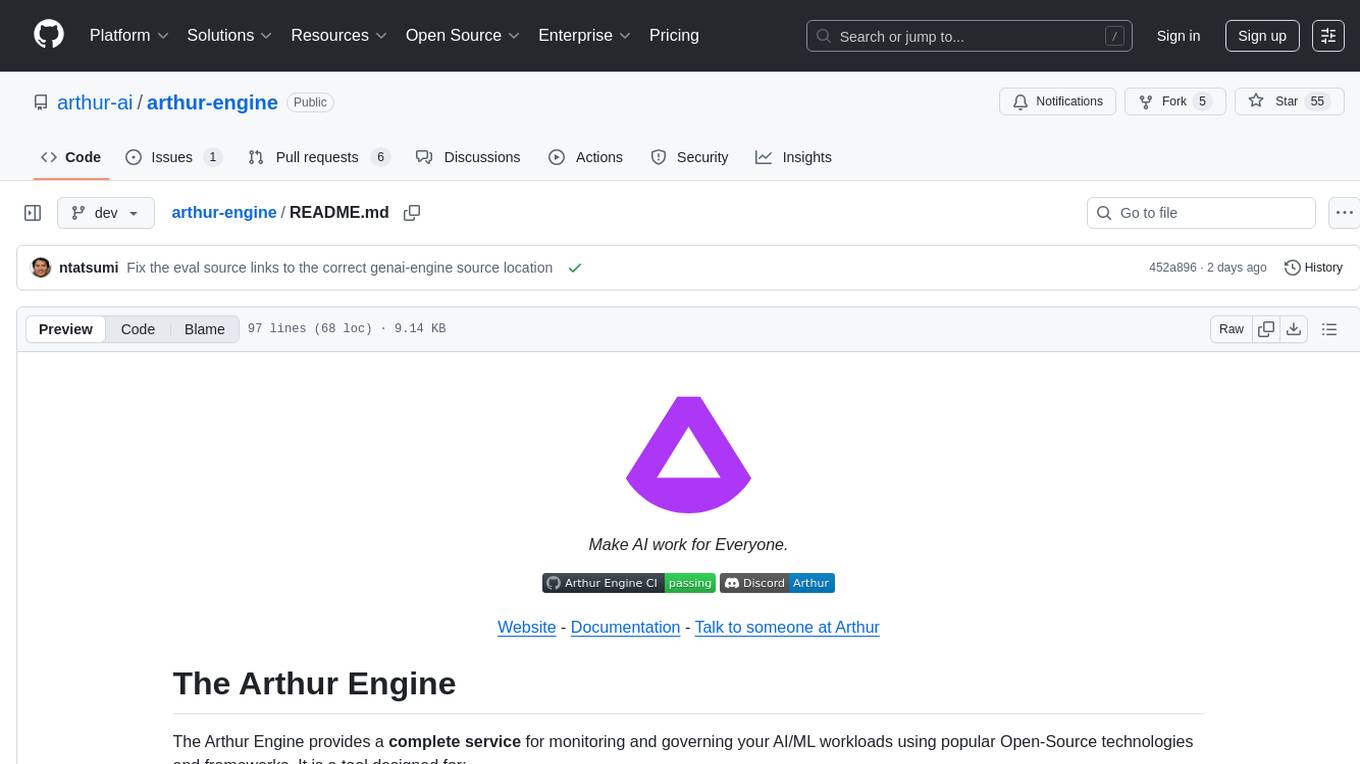
arthur-engine
The Arthur Engine is a comprehensive tool for monitoring and governing AI/ML workloads. It provides evaluation and benchmarking of machine learning models, guardrails enforcement, and extensibility for fitting into various application architectures. With support for a wide range of evaluation metrics and customizable features, the tool aims to improve model understanding, optimize generative AI outputs, and prevent data-security and compliance risks. Key features include real-time guardrails, model performance monitoring, feature importance visualization, error breakdowns, and support for custom metrics and models integration.
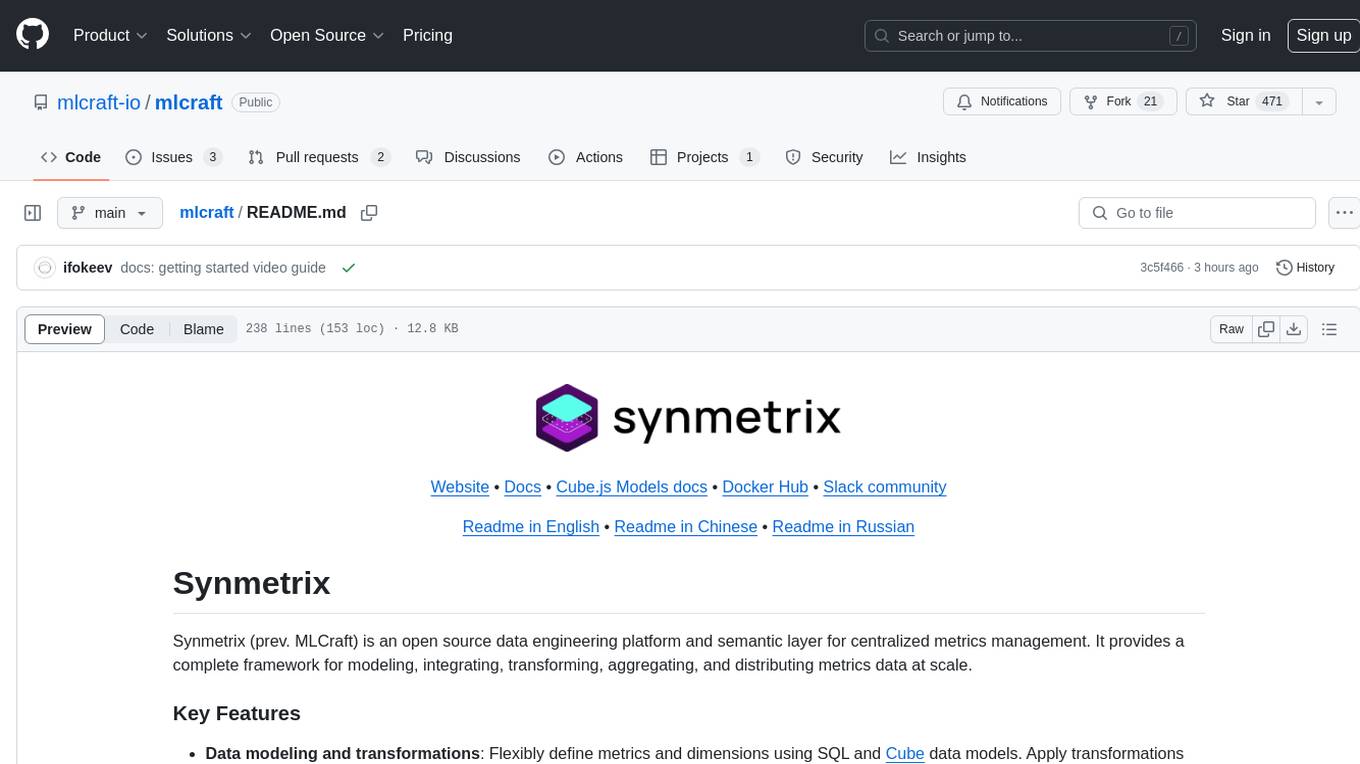
mlcraft
Synmetrix (prev. MLCraft) is an open source data engineering platform and semantic layer for centralized metrics management. It provides a complete framework for modeling, integrating, transforming, aggregating, and distributing metrics data at scale. Key features include data modeling and transformations, semantic layer for unified data model, scheduled reports and alerts, versioning, role-based access control, data exploration, caching, and collaboration on metrics modeling. Synmetrix leverages Cube (Cube.js) for flexible data models that consolidate metrics from various sources, enabling downstream distribution via a SQL API for integration into BI tools, reporting, dashboards, and data science. Use cases include data democratization, business intelligence, embedded analytics, and enhancing accuracy in data handling and queries. The tool speeds up data-driven workflows from metrics definition to consumption by combining data engineering best practices with self-service analytics capabilities.

second-brain-ai-assistant-course
This open-source course teaches how to build an advanced RAG and LLM system using LLMOps and ML systems best practices. It helps you create an AI assistant that leverages your personal knowledge base to answer questions, summarize documents, and provide insights. The course covers topics such as LLM system architecture, pipeline orchestration, large-scale web crawling, model fine-tuning, and advanced RAG features. It is suitable for ML/AI engineers and data/software engineers & data scientists looking to level up to production AI systems. The course is free, with minimal costs for tools like OpenAI's API and Hugging Face's Dedicated Endpoints. Participants will build two separate Python applications for offline ML pipelines and online inference pipeline.
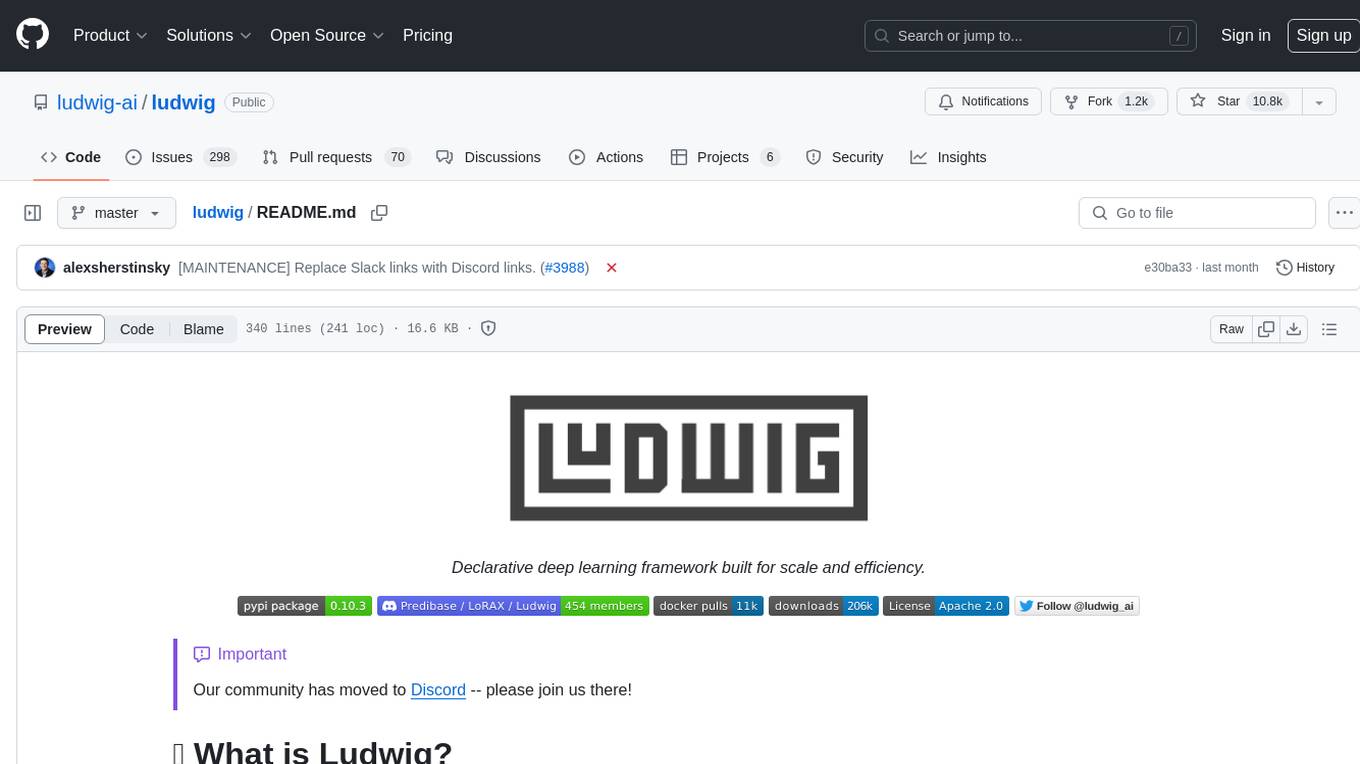
ludwig
Ludwig is a declarative deep learning framework designed for scale and efficiency. It is a low-code framework that allows users to build custom AI models like LLMs and other deep neural networks with ease. Ludwig offers features such as optimized scale and efficiency, expert level control, modularity, and extensibility. It is engineered for production with prebuilt Docker containers, support for running with Ray on Kubernetes, and the ability to export models to Torchscript and Triton. Ludwig is hosted by the Linux Foundation AI & Data.
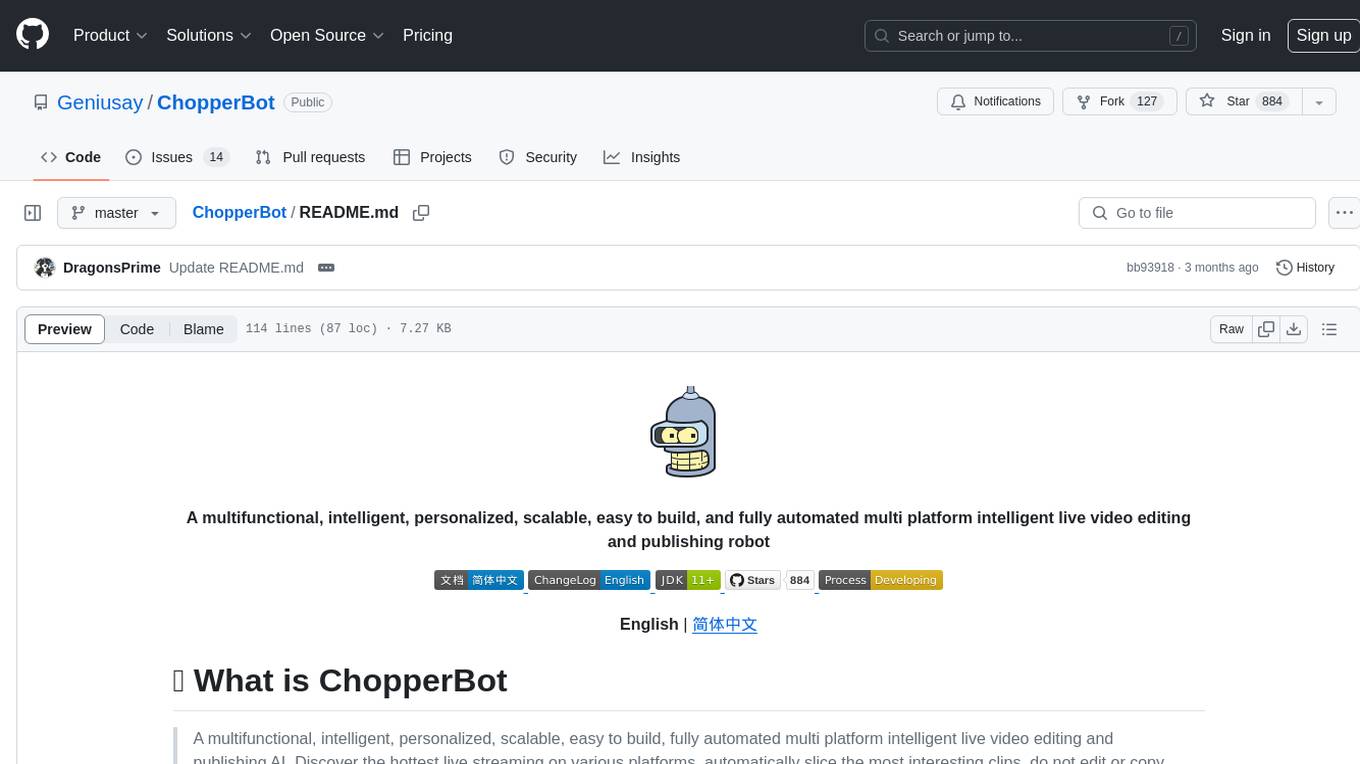
ChopperBot
A multifunctional, intelligent, personalized, scalable, easy to build, and fully automated multi platform intelligent live video editing and publishing robot. ChopperBot is a comprehensive AI tool that automatically analyzes and slices the most interesting clips from popular live streaming platforms, generates and publishes content, and manages accounts. It supports plugin DIY development and hot swapping functionality, making it easy to customize and expand. With ChopperBot, users can quickly build their own live video editing platform without the need to install any software, thanks to its visual management interface.
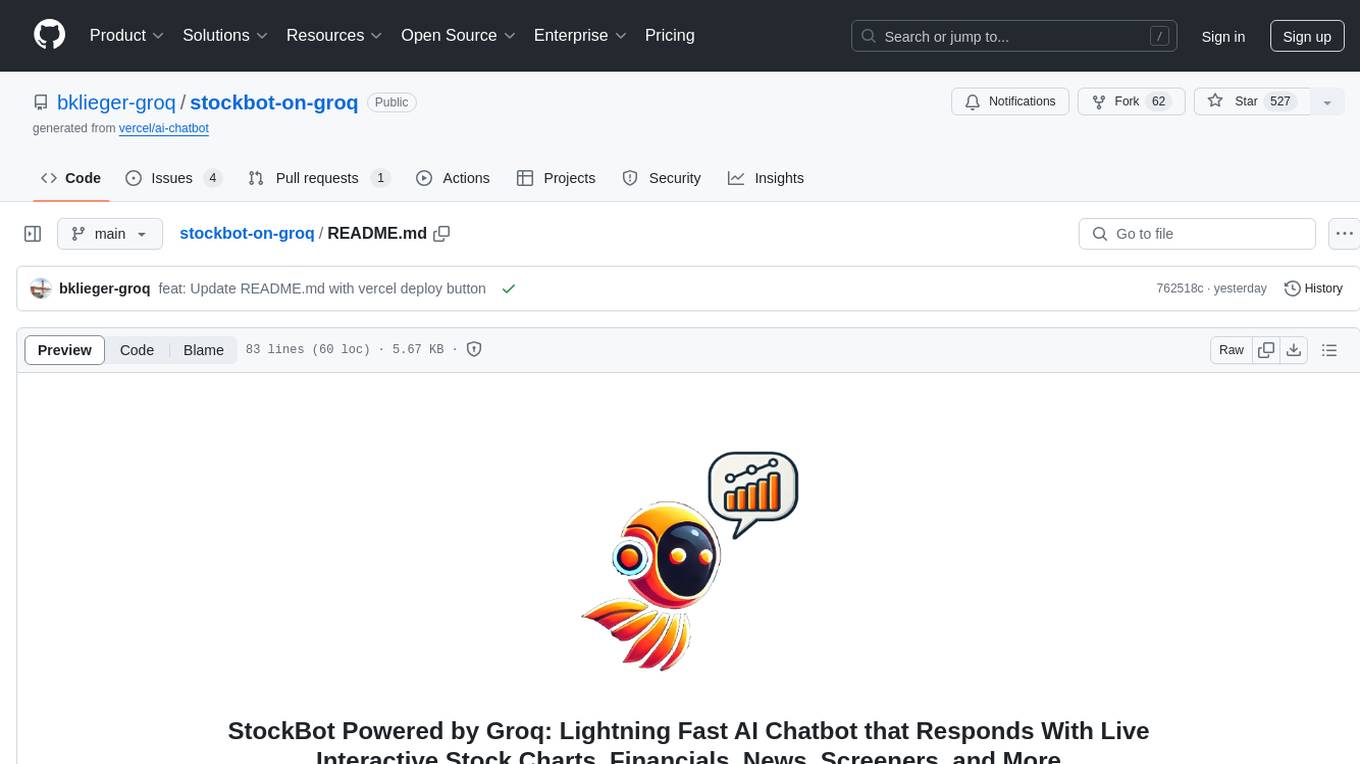
stockbot-on-groq
StockBot Powered by Groq is an AI-powered chatbot that provides lightning-fast responses with live interactive stock charts, financial data, news, screeners, and more. Leveraging Groq's speed and Vercel's AI SDK, StockBot offers real-time conversation with natural language processing, interactive TradingView charts, adaptive interfaces, and multi-asset market coverage. It is designed for entertainment and instructional use, not for investment advice.
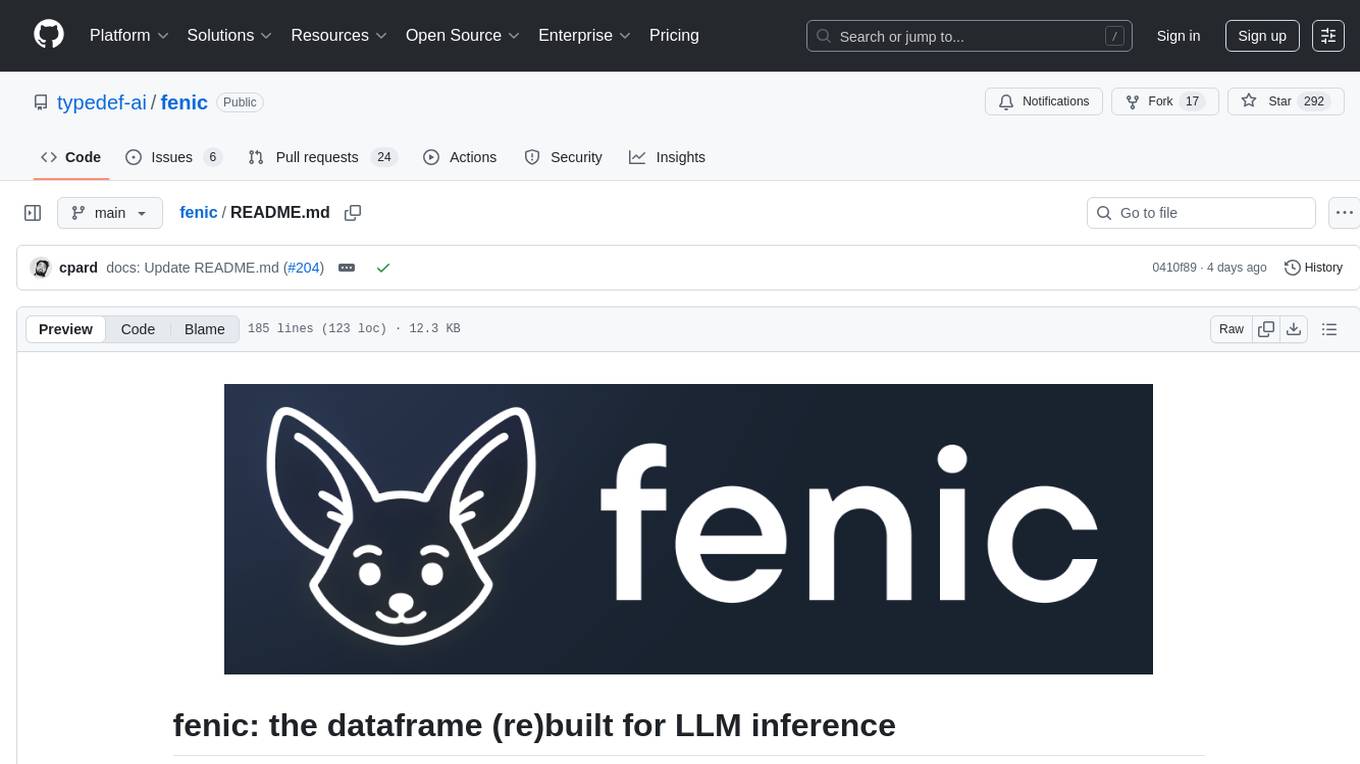
fenic
fenic is an opinionated DataFrame framework from typedef.ai for building AI and agentic applications. It transforms unstructured and structured data into insights using familiar DataFrame operations enhanced with semantic intelligence. With support for markdown, transcripts, and semantic operators, plus efficient batch inference across various model providers. fenic is purpose-built for LLM inference, providing a query engine designed for AI workloads, semantic operators as first-class citizens, native unstructured data support, production-ready infrastructure, and a familiar DataFrame API.
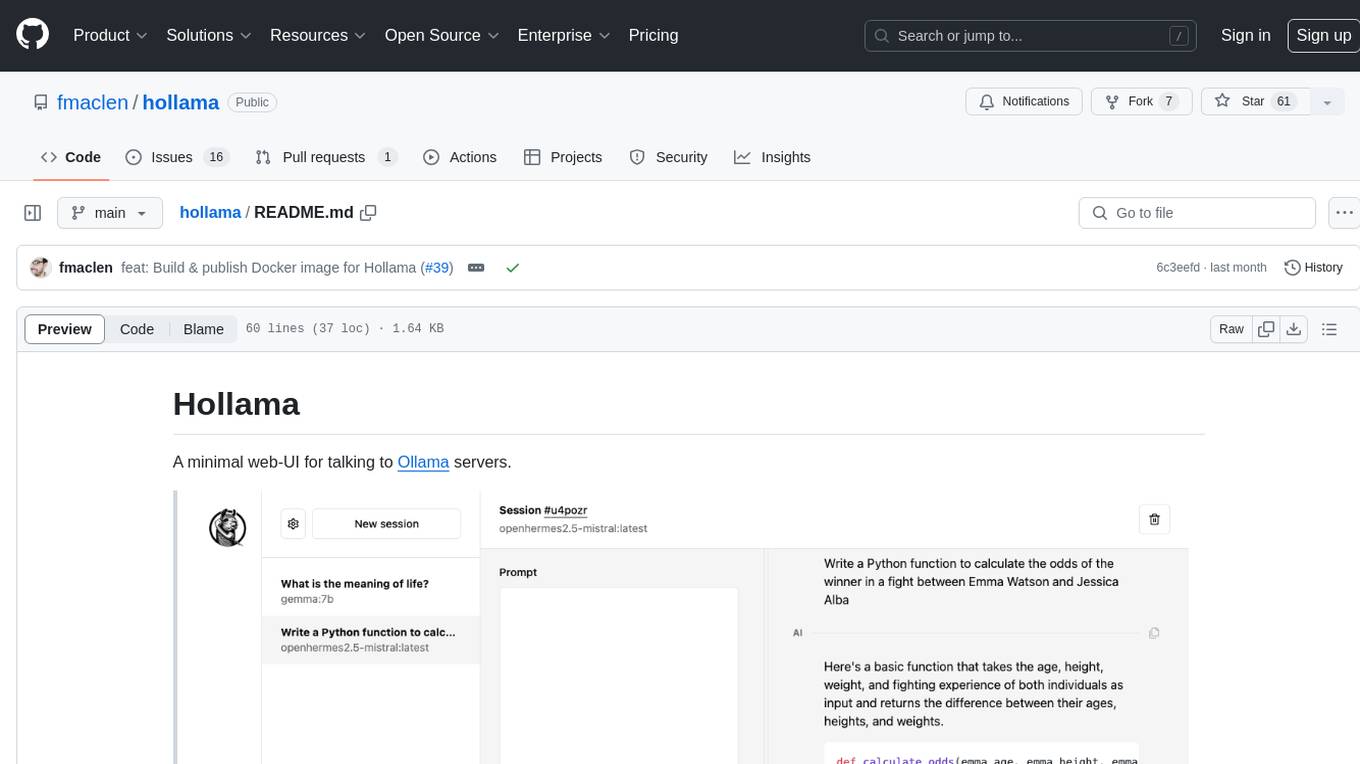
hollama
Hollama is a minimal web-UI tool designed for interacting with Ollama servers. It features large prompt fields, streams completions, ability to copy completions as raw text, Markdown parsing with syntax highlighting, and saves sessions/context in the browser's localStorage. Users can access the latest version of Hollama at https://hollama.fernando.is without sign up, and data is stored locally on the browser. The tool can also be run as a Docker image by executing a specific command. Developers can connect to an Ollama server by updating the ORIGIN settings. Hollama facilitates easy development by providing instructions to set up the environment, install dependencies, and start a development server. Building a production version of the app is straightforward with a single command, and deployment may require installing an adapter for the target environment.
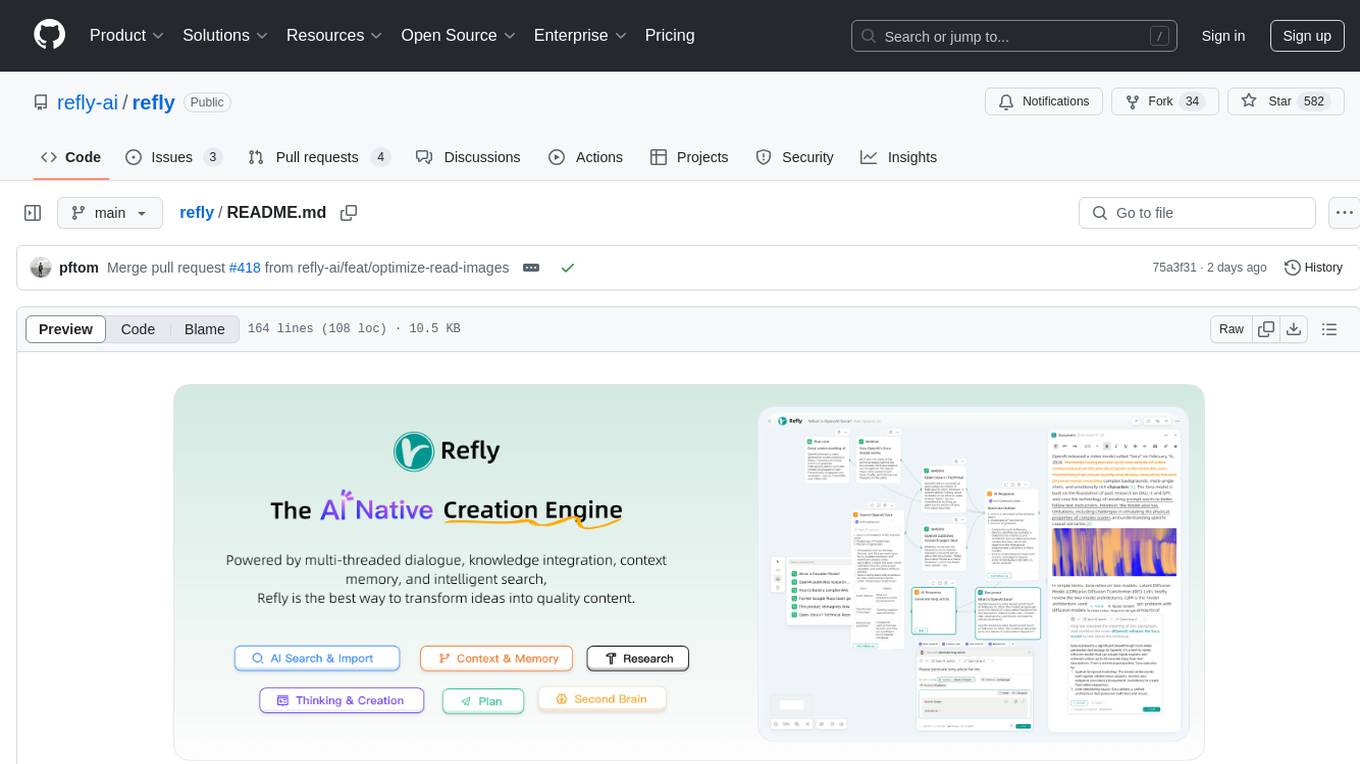
refly
Refly.AI is an open-source AI-native creation engine that empowers users to transform ideas into production-ready content. It features a free-form canvas interface with multi-threaded conversations, knowledge base integration, contextual memory, intelligent search, WYSIWYG AI editor, and more. Users can leverage AI-powered capabilities, context memory, knowledge base integration, quotes, and AI document editing to enhance their content creation process. Refly offers both cloud and self-hosting options, making it suitable for individuals, enterprises, and organizations. The tool is designed to facilitate human-AI collaboration and streamline content creation workflows.
For similar tasks

kubesphere
KubeSphere is a distributed operating system for cloud-native application management, using Kubernetes as its kernel. It provides a plug-and-play architecture, allowing third-party applications to be seamlessly integrated into its ecosystem. KubeSphere is also a multi-tenant container platform with full-stack automated IT operation and streamlined DevOps workflows. It provides developer-friendly wizard web UI, helping enterprises to build out a more robust and feature-rich platform, which includes most common functionalities needed for enterprise Kubernetes strategy.
For similar jobs

AirGo
AirGo is a front and rear end separation, multi user, multi protocol proxy service management system, simple and easy to use. It supports vless, vmess, shadowsocks, and hysteria2.
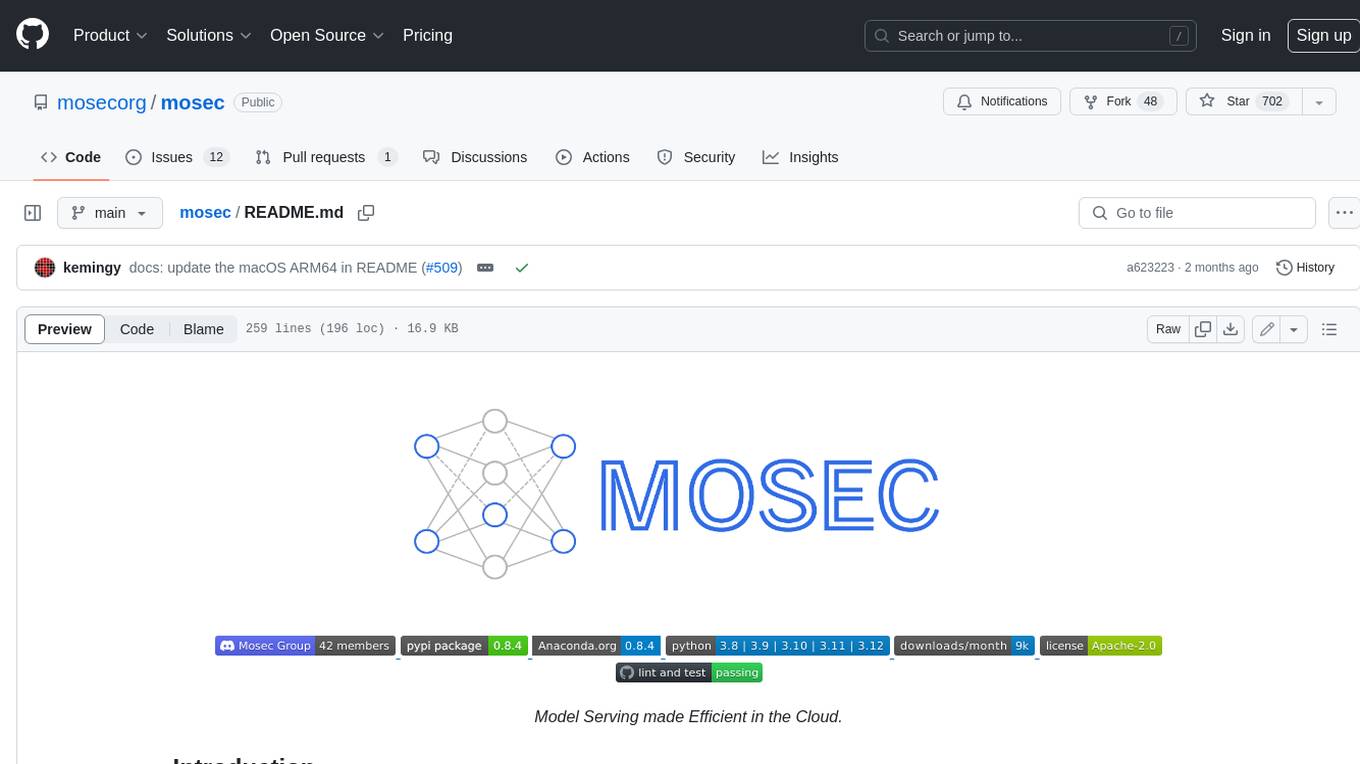
mosec
Mosec is a high-performance and flexible model serving framework for building ML model-enabled backend and microservices. It bridges the gap between any machine learning models you just trained and the efficient online service API. * **Highly performant** : web layer and task coordination built with Rust 🦀, which offers blazing speed in addition to efficient CPU utilization powered by async I/O * **Ease of use** : user interface purely in Python 🐍, by which users can serve their models in an ML framework-agnostic manner using the same code as they do for offline testing * **Dynamic batching** : aggregate requests from different users for batched inference and distribute results back * **Pipelined stages** : spawn multiple processes for pipelined stages to handle CPU/GPU/IO mixed workloads * **Cloud friendly** : designed to run in the cloud, with the model warmup, graceful shutdown, and Prometheus monitoring metrics, easily managed by Kubernetes or any container orchestration systems * **Do one thing well** : focus on the online serving part, users can pay attention to the model optimization and business logic
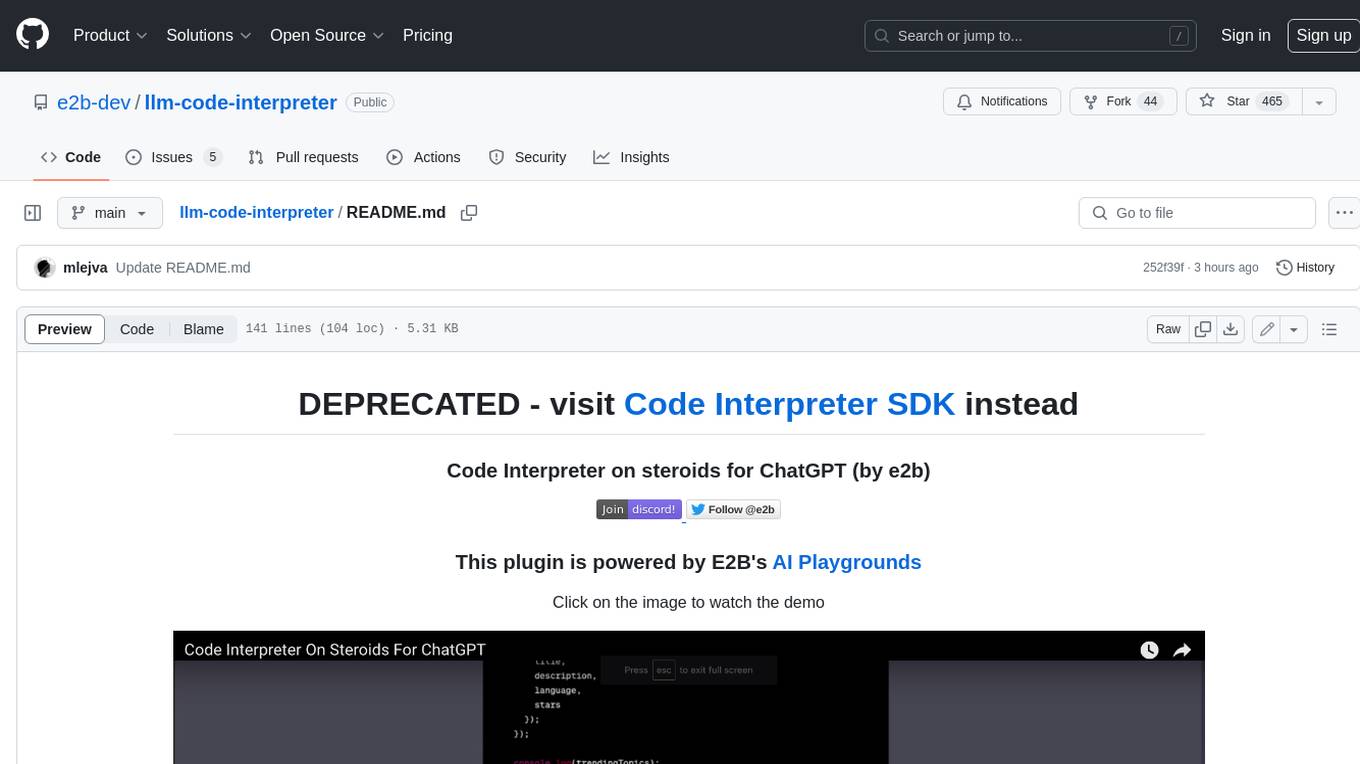
llm-code-interpreter
The 'llm-code-interpreter' repository is a deprecated plugin that provides a code interpreter on steroids for ChatGPT by E2B. It gives ChatGPT access to a sandboxed cloud environment with capabilities like running any code, accessing Linux OS, installing programs, using filesystem, running processes, and accessing the internet. The plugin exposes commands to run shell commands, read files, and write files, enabling various possibilities such as running different languages, installing programs, starting servers, deploying websites, and more. It is powered by the E2B API and is designed for agents to freely experiment within a sandboxed environment.

pezzo
Pezzo is a fully cloud-native and open-source LLMOps platform that allows users to observe and monitor AI operations, troubleshoot issues, save costs and latency, collaborate, manage prompts, and deliver AI changes instantly. It supports various clients for prompt management, observability, and caching. Users can run the full Pezzo stack locally using Docker Compose, with prerequisites including Node.js 18+, Docker, and a GraphQL Language Feature Support VSCode Extension. Contributions are welcome, and the source code is available under the Apache 2.0 License.
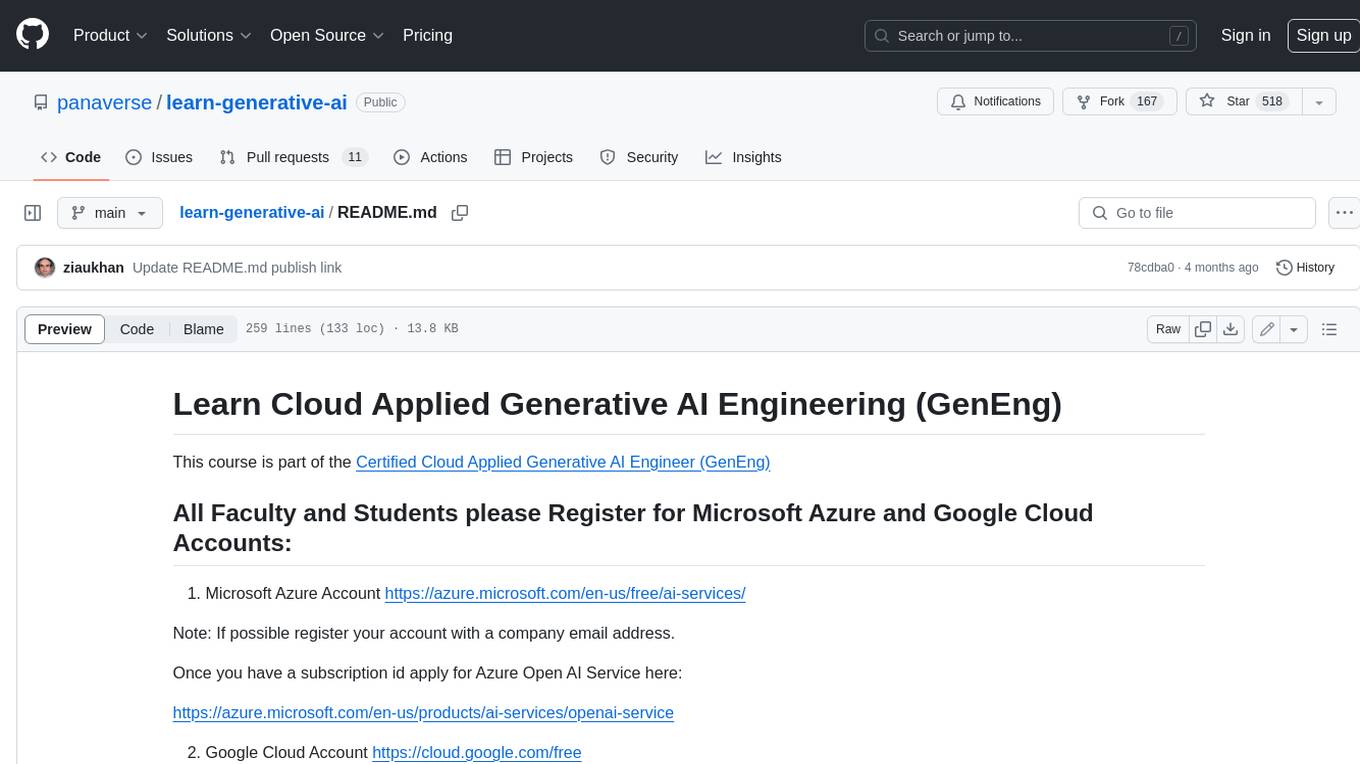
learn-generative-ai
Learn Cloud Applied Generative AI Engineering (GenEng) is a course focusing on the application of generative AI technologies in various industries. The course covers topics such as the economic impact of generative AI, the role of developers in adopting and integrating generative AI technologies, and the future trends in generative AI. Students will learn about tools like OpenAI API, LangChain, and Pinecone, and how to build and deploy Large Language Models (LLMs) for different applications. The course also explores the convergence of generative AI with Web 3.0 and its potential implications for decentralized intelligence.
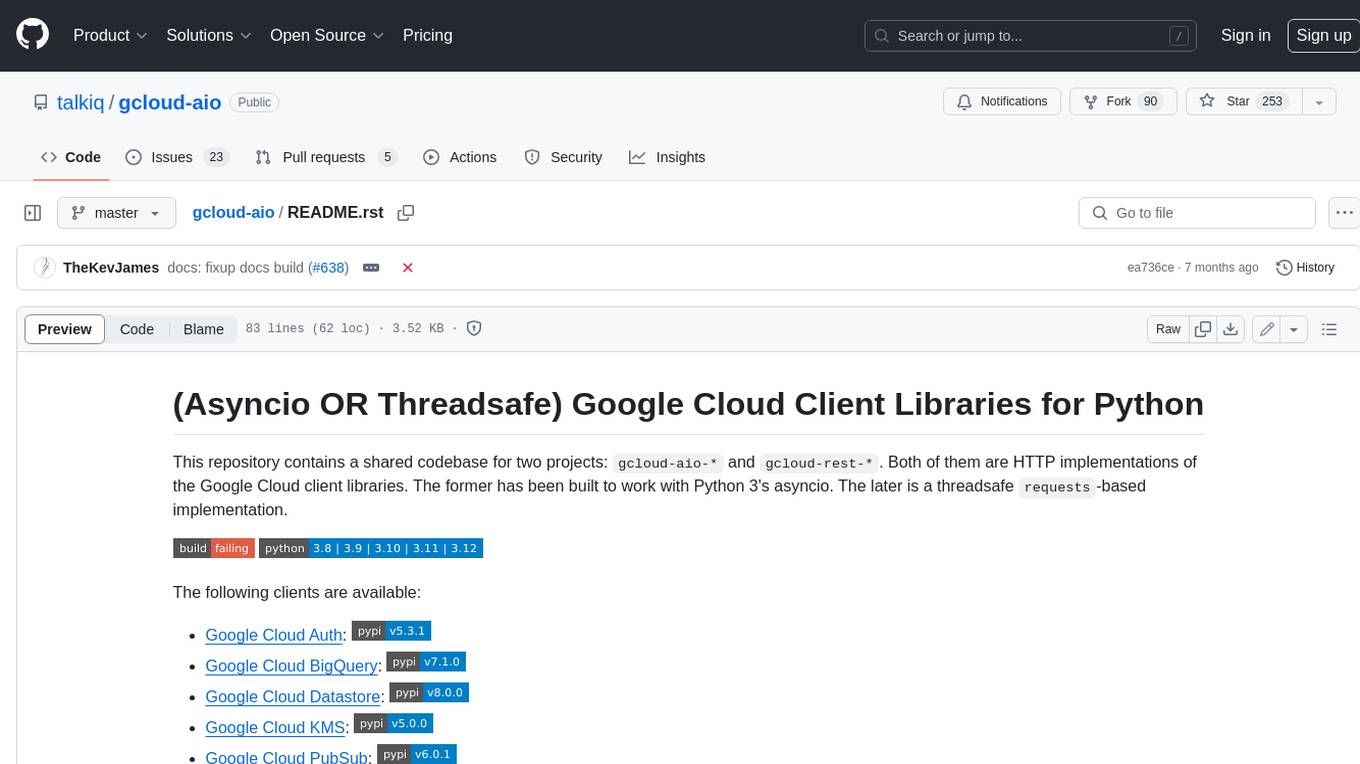
gcloud-aio
This repository contains shared codebase for two projects: gcloud-aio and gcloud-rest. gcloud-aio is built for Python 3's asyncio, while gcloud-rest is a threadsafe requests-based implementation. It provides clients for Google Cloud services like Auth, BigQuery, Datastore, KMS, PubSub, Storage, and Task Queue. Users can install the library using pip and refer to the documentation for usage details. Developers can contribute to the project by following the contribution guide.
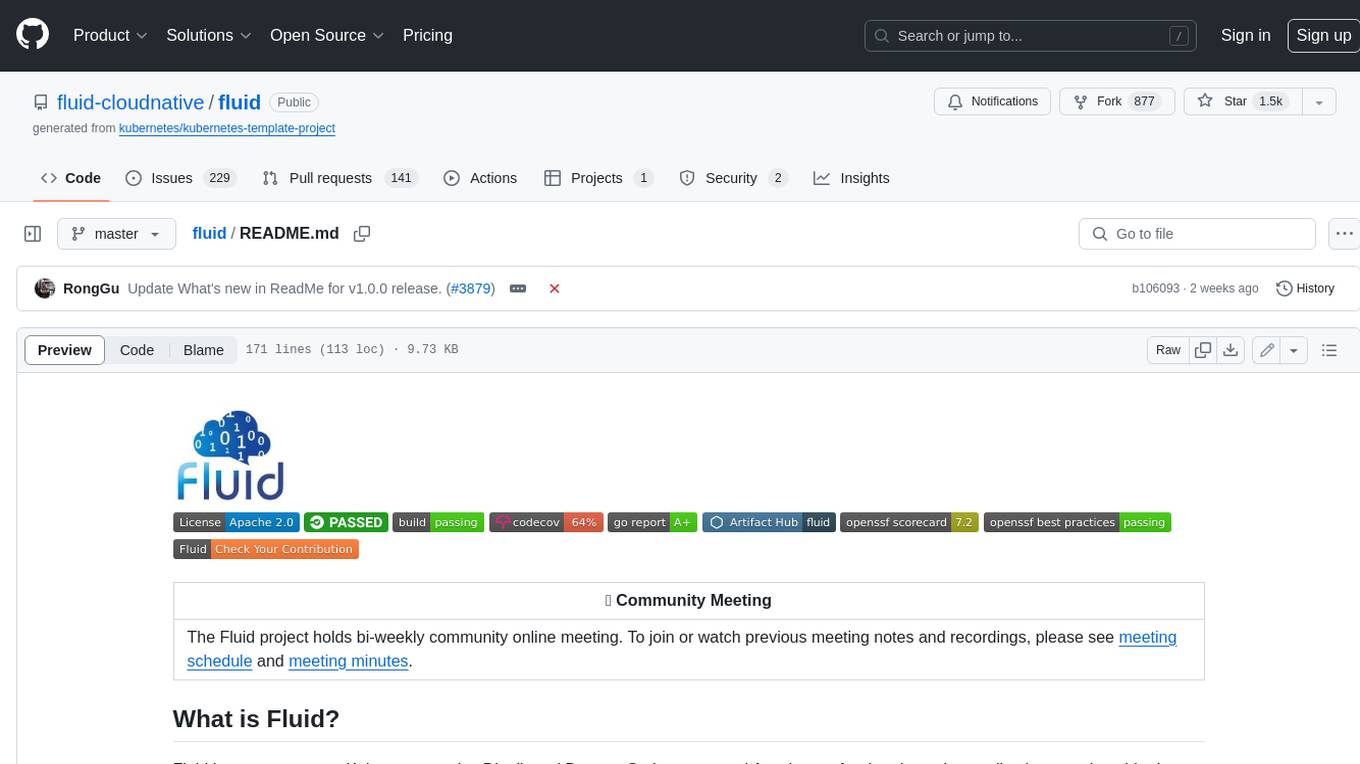
fluid
Fluid is an open source Kubernetes-native Distributed Dataset Orchestrator and Accelerator for data-intensive applications, such as big data and AI applications. It implements dataset abstraction, scalable cache runtime, automated data operations, elasticity and scheduling, and is runtime platform agnostic. Key concepts include Dataset and Runtime. Prerequisites include Kubernetes version > 1.16, Golang 1.18+, and Helm 3. The tool offers features like accelerating remote file accessing, machine learning, accelerating PVC, preloading dataset, and on-the-fly dataset cache scaling. Contributions are welcomed, and the project is under the Apache 2.0 license with a vendor-neutral approach.
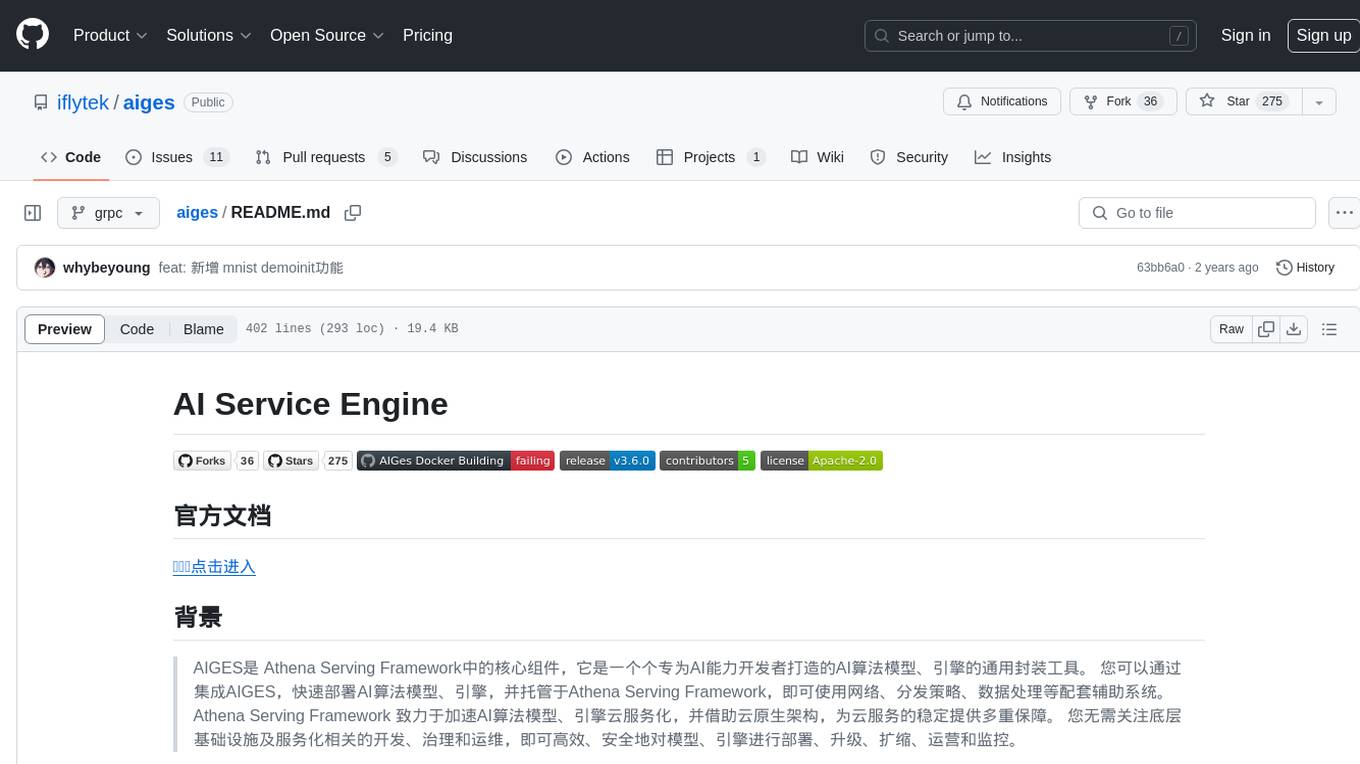
aiges
AIGES is a core component of the Athena Serving Framework, designed as a universal encapsulation tool for AI developers to deploy AI algorithm models and engines quickly. By integrating AIGES, you can deploy AI algorithm models and engines rapidly and host them on the Athena Serving Framework, utilizing supporting auxiliary systems for networking, distribution strategies, data processing, etc. The Athena Serving Framework aims to accelerate the cloud service of AI algorithm models and engines, providing multiple guarantees for cloud service stability through cloud-native architecture. You can efficiently and securely deploy, upgrade, scale, operate, and monitor models and engines without focusing on underlying infrastructure and service-related development, governance, and operations.





